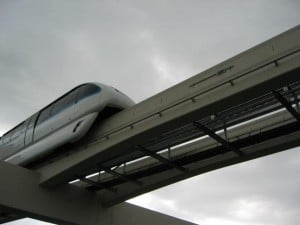On Mar. 11, 2013 in “American public transit use climbs, vehicle miles driven retreats,” I opined: “What really matters most, in my view, is performance or efficiency of mode type, and with this information, a more meaningful land-transportation-performance or efficiency story is told.
“In addition, another relevant parameter is trip time.”
![320px-FLV_California_train[1]](https://alankandel.scienceblog.com/files/2012/11/320px-FLV_California_train1.jpg)
Furthermore, before concluding yesterday’s post I offered: “Doing additional research to find answers to [questions that were posed] if not presenting the findings in a follow-up report just might be in order.”
Having said that, in this three-part series, delved into are the efficiency/performance (e/p) constructs of rail transit, followed in parts 2 and 3 by e/p of car and transit bus modes, respectively.
The dirty “D” word: Delay
Also from yesterday’s post I pointed out: “According to one analysis, Americans in motor vehicles in 2011 were delayed 5.5 billion hours resulting in 2.9 billion gallons of fuel being wasted at a congestion cost of $121 billion.”
This isn’t to say delay cannot affect passengers on passenger trains – it can.
In regard to the San Francisco Bay Area Rapid Transit District (BART) trains, Michael Cabanatuan in the San Francisco Chronicle wrote: “BART delays are relatively uncommon. The transit agency boasts a 94 to 95 percent on-time rate, which has remained fairly consistent over at least the past decade. But even if BART hits that mark, it means 42 late trains per day – and if your train is among them, you’re not pleased.”
Listed are several factors that can lead to transit train delays. Some are obviously outside a transit agency’s control. These, in no particular order, are:
- Computerized control, electrical and train propulsion system glitches or failures
- Crime (theft, ticket purchase evasion, vandalism, etc.)
- Malfunctioning doors and brake systems
- Train equipment malfunctions or failures
- Collisions with pedestrians or vehicles
- Onboard medical emergencies
- Weather-related problems
“The average long delay (of more than 15 minutes) was 19 minutes, and it typically caused five secondary delays elsewhere in the system. The longest single delay was an hour and 23 minutes after a person was hit by a train,” Cabanatuan pointed out. “The lengthiest collection of secondary delays – a cumulative four hours and 50 minutes – happened when the Chevron refinery explosion in Richmond forced BART to shut down three stations.”
Making delay go away
Delays seem inevitable. The key here is to try to minimize them.
Ways to do this could involve: purchase of new equipment (that is, equipment that is less prone to failures and malfunctions); better management and oversight of operations and equipment maintenance; better scheduling of train runs and/or the extension of service hours; the addition of ancillary services (this could include the placement of onboard security personnel and the staffing of stations with paramedics).
Something else to consider: The more people there are that utilize rail transit to meet daily mobility needs, presumably, the fewer people there are occupying space on roadways. And the fewer the number of people taking up valuable roadway space, the presumption is, the better the vehicle flow on the affected road. With people switching from cars to transit trains roadway volume could be lessened and, with that, the possibility exists that the addition of more train riders could adversely affect train operations. However, I just don’t see this being a serious problem unless trains are overwhelmed. In that case, more cars per train or more trains could be added to accommodate the increased passenger demand.
Thom Patterson, meanwhile, in “Commuters give up the ‘ball and chain,’” wrote: “Places like Salt Lake City and Phoenix, which fostered rail transit during the past decade, are now seeing community benefits like lower traffic congestion and increased economic activity.”

Nixing NOx
In Utah, Patterson noted, “Lawmakers are considering using public transit to battle the region’s smog problem. A proposal would offer free access to light rail during January and July, Utah’s worst months for smog.”
Yep, there is that aspect too.
– Alan Kandel